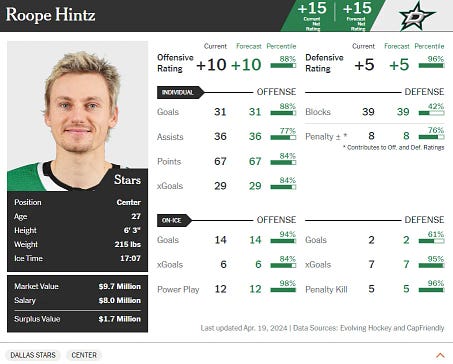The app for independent voices
Evergreen note: “Analytics” are not mere numbers. They’re models: ways of bridging practical (what happens on ice) and theoretical knowledge (what will or can happen based on ice based on prior events). They help define the conditions of performance over a period of time rather than glimpsing raw plus-minus. The climate versus the weather. These are not meant to be a right or wrong way to look at a hockey game; they’re meant to be useful in understanding the conditions of hockey itself.
The Stat: Dom Luszczyszyn’s Net Rating.
The question Net Rating attempts to answer: Which player had the best night — and which player seems to consistently have the best night?
How it answers that question: Luszczyszyn's Net Rating has evolved over the years, but it began with that central question when he applied the concept of Game Score to hockey. The idea was to give a rough measure of single-game productivity. Initially Luszczyszyn’s GS model started from a similar pot as WAR, with an emphasis on goals, primary assists, secondary assists, shots on goal, blocked shots, penalty differential, faceoffs, and 5-on-5 shot attempt differential. That soon evolved into Game Score Value Added, which adjusted for age, teammates, and competion at 5-on-5. This stat was Game Score translated into wins.
So why is it called Net Rating now? Luszczyszyn famously focused on Corsi (or shot attempts) because Corsi was still a better predictor of future goals than shot quality models at the time. However, because Luszczyszyn does not watch the games on a spreadsheet, he noticed his models were underrating a lot of defensively good teams who seemed to have a discrepency between their broad possession (Corsi) and specific possession (expected goals). Teams like Dallas and St. Louis fell into the latter category while teams like Chicago and Anaheim fell into the former.
To better account for defense, Luszczyszyn separated the individual game score differential from the team's offense and defense differential, finding that defensemen had a much more pronounced discrepancy than forwards -- something that makes intuitive sense given that many stats focus on outcomes, and forwards influence scoring more than defenders.
Now Luszczyszyn has offense and defense separate. Is there yet another wrinkle? Yes. As scoring has increased, actual goals are becoming more predictive than expected goals. To quote Luszczyszyn himself:
"The separation of offensive and defensive metrics in GSVA is a long overdue one and that increase in goals per game since 2017-18 is part of the reason why it’s so vital. When goals become less scarce the ability to diminish them becomes more important."
Below is a player card for Roope Hintz, with each unit measured in goals.
Further reading:

